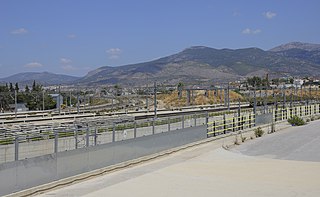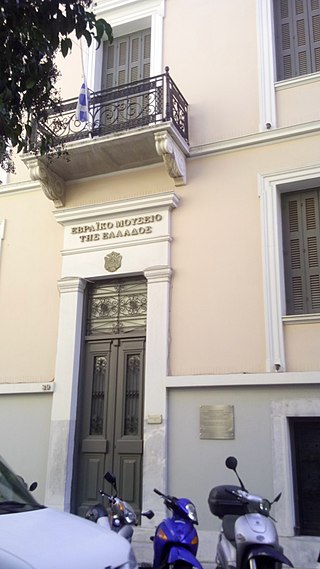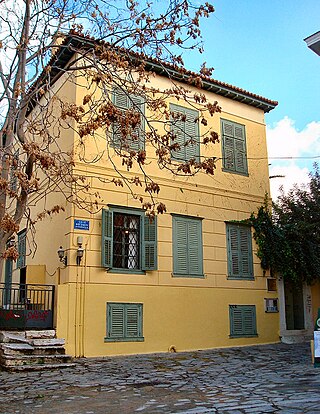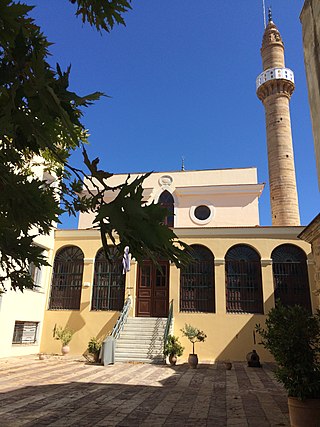
Acharnes is a municipality in the East Attica regional unit in Greece. With 108,169 inhabitants, it is the ninth most populous municipality in Greece. It lies just north of the Athens urban area.

The Hellenic Coast Guard is the national coast guard of Greece. Like many other coast guards, it is a paramilitary organization that can support the Hellenic Navy in wartime, but resides under separate civilian control in times of peace. The officers and the enlisted members of the Coast Guard are regarded as military personnel under Military's Penal Code. It was founded in 1919 by an Act of Parliament and the legal framework for its function was reformed in 1927. Its primary mission is the enforcement of Greek, European and International law in the maritime areas.

The Michael C. Carlos Museum is an art museum located in Atlanta on the historic quadrangle of Emory University's main campus. The Carlos Museum has the largest ancient art collections in the Southeast, including objects from ancient Egypt, Greece, Rome, the Near East, Africa and the ancient Americas. The collections are housed in a Michael Graves designed building which is open to the public.

Sparta is a city and municipality in Laconia, Peloponnese, Greece. It lies at the site of ancient Sparta within the Evrotas Valley. The municipality was merged with six nearby municipalities in 2011, for a total population of 32,786, of whom 17,773 lived in the city.

The Archaeological Museum of Piraeus contains mainly sculptures, discovered in Piraeus and in the area of the Attic coast from Bronze Age to Roman times,

Ilias Lalaounis Jewelry Museum is a museum in Athens, Greece, created by the renowned Greek jewellery designer Ilias Lalaounis. The ILJM is located near the Acropolis, at the corner of Karyatidon and Kallisperi streets. It comprises 50 collections of a total of over 4,000 jewels and small ornaments dedicated to the history and art of jewellery making. The permanent exhibition displays more than 3000 pieces designed in the period 1940–1992.

The Jewish Museum of Greece is a museum in Athens, Greece. It was established by Nicholas Stavroulakis in 1977 to preserve the material culture of the Greek Jews. The museum displays the 2,300 years of Greek Jewish history through the material artifacts in its possession. The collections and archives of the museum contain over 10,000 artifacts. Included in the museum is an art gallery, a periodic exhibition space, a research library, and photo archive and conservation laboratories.
The Spathario Shadow Theatre Museum is a museum in Maroussi, Athens, Greece. It exhibits mostly shadow puppet artifacts and it is named after prominent Greek puppet shadow artist Evgenios Spatharis. It was established in 1991 in the municipality of Maroussi and opened in 1996.

The Marika Kotopouli Museum is a modern art museum in Zografou, Athens, Greece. The building housing the museum was built by the famous Greek theater actress Marika Kotopouli (1887–1954) as her holiday home in 1926. During the Second World War, the house was requisitioned by the Germans and after the war it housed the local Police Station. The Zographou Municipality with support of the Association of Greek Actors restored the building with its distinctive architecture and beautiful interiors. In 1990, it opened to the public as a museum of modern art. It hosts various interim art exhibitions as well as the permanent collection of Konstantinos Ioannides.
Υannis Tsarouchis Foundation Museum is an art museum in Marousi, a northern suburb of Athens, Greece, dedicated to the famous Greek painter Yannis Tsarouchis. The museum is housed in the headquarters of the Foundation, which was formed in 1981, with the aim of assembling an as complete as possible collection of paintings representing all aspects of his work, to make a detailed inventory of the paintings, conserver them, organize exhibitions in the museum and participate in exhibitions organized by other institutions. There are exhibition rooms in the first floor and in the attic.

The Museum of Greek Folk Art is a museum in Athens, Greece. The museum was founded in 1918 as the Museum of Greek Handicrafts in the Tzistarakis Mosque in Monastiraki, which later became the National Museum of Decorative Arts and in 1959 it obtained its current name. In 1973 the greater part of the collection and the main functions of the museum were moved to 17 Kydathinaion Str. in Plaka and the mosque was annexed to it. Other annexes are the old "Public Baths" at Kyrristou 8 and one at Thespidos 8, both also in Plaka.

The Museum of Greek Folk Musical Instruments, is a museum and Research Centre for Ethnomusicology in the Lassanis Mansion, Plaka, Athens, Greece. It displays about 600 Greek musical instruments from the last 300 years and has as many more in store.

The Museum of the Kalavryta Holocaust is a museum in Kalavryta, Greece dedicated to the history of the Massacre of Kalavryta in 1943. The museum contains artifacts of the German occupation of the town and documents the massacre.

The Folk Life and Ethnological Museum of Macedonia and Thrace is located in Thessaloniki, Central Macedonia, Greece. It was founded in 1973 by the Macedonian Educational Association and is housed in the building known as Old Government House or Villa Modiano, which was built in 1906 by the architect Eli Modiano, on a 5 hectare plot of land by the sea, for the banker Jacob Modiano. The museum is on four levels, with a semi-basement, two floors, and an attic. Architecturally it is an eclectic structure strongly influenced by Art Nouveau. Particularly impressive is the double loggia with a view of the sea.

The Chios Byzantine Museum is a museum in Chios, Greece, housed in an Ottoman-era mosque that was known as the Mecidiye Mosque.

The Kentucky Folk Art Center is a folk art museum administered by Morehead State University in Morehead, Kentucky, United States. Its focus is not only to preserve and educate the public on visual Appalachian folk art but also to promote traditional Appalachian traditional music, storytelling, literature, dance, and crafts.
The Archaeological Museum of Thebes is a museum in Thebes, Greece dedicated to the Boeotia region.

Drossinis Museum is in the center of Kifisia, a northern suburb of Athens, and it is housed in “Amaryllis” villa, where Georgios Drossinis lived in his last years and which is named after a central character of one of his earliest and most popular works. The museum was founded in 1997 with the aim to preserve and promote Drossinis’ (1859-1951) multidimensional work. Drossinis, along with Costis Palamas and Nikos Kampas co-founded the New Athenian School, the Greek literary ‘1880s Generation’, a movement which renewed Greek literature and fought for the establishment of modern Greek language ("Demotic") The museum includes three halls, which are on the first floor, while the ground floor houses the Municipal Library of Kifisia, according to Drossinis's wish.

The Kastellorizo Folk Art Museum is a museum in the small island of Kastellorizo, Greece, housed in a historical Ottoman-era mosque that was known as the Kavos Mosque or simply the Kastellorizo Mosque.














